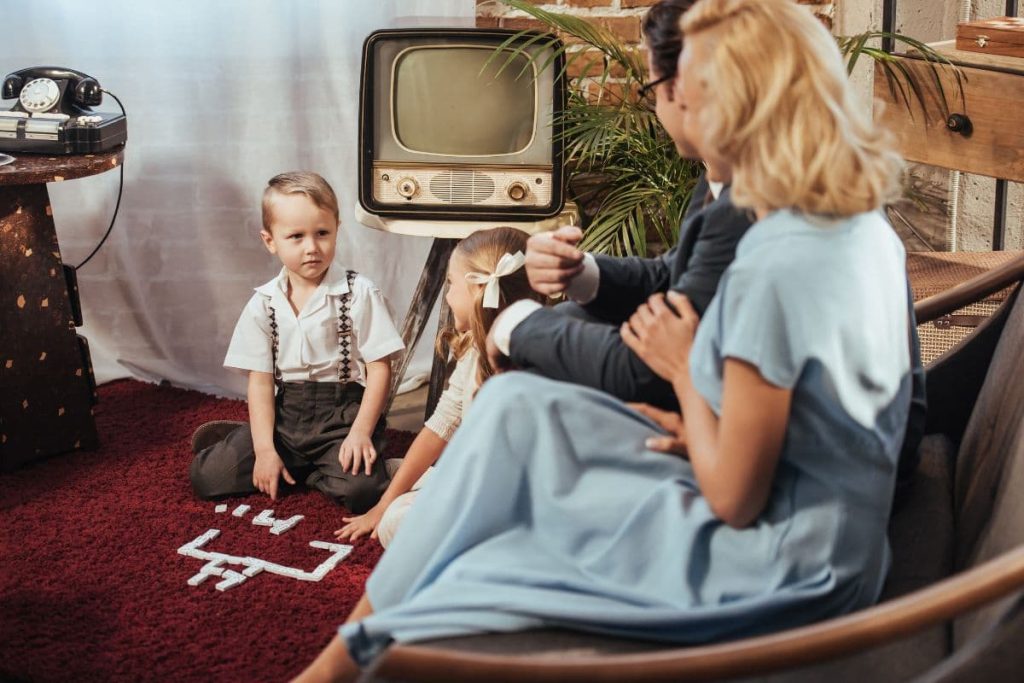Remember the days when parenting seemed more straightforward, or perhaps just different from today? Well, kind of. I grew up in the 90s, and my parents let my siblings and I be a little more free-range than most parents today. Either way, it’s cool to look back to see how parenting has changed through the decades.
As we take a nostalgic trip back to parenting through the decades, we get to see the evolution of parenting, witnessing how the family dynamic and parenting approaches have undergone significant transformations.
Key Takeaways:
- Each parenting style of married parents has dynamically transformed over the decades with societal and cultural shifts.
- Changes in family structure and the surge of media and technology have impacted child-rearing practices and parenting skills.
- Economic considerations continue to influence parenting decisions between two-parent households and adult children.
Parenting through the Decades

The historical evolution of parenting has seen a dynamic shift across decades, influenced by various societal and psychological factors. In earlier times, parenting was often characterized by the traditional two-parent household model, where married parents adopted a more directive style.
As the years progressed, societal changes led to a greater awareness of the importance of positive parenting, which values open communication, empathy, and understanding.
Today, approximately 43% of parents aim to mirror the parenting styles of their own parents in raising their children.
However, this evolution has also introduced new challenges, such as too much parental involvement, where parents struggle to find the right balance between supporting and overbearing. The shift towards more emotionally intelligent parenting highlights the ongoing journey of adapting a parenting style to meet the changing needs of children and society.
The Impact of Culture and Society
Culture and society exert a profound influence on parenting. They send cues about gender roles, societal expectations, and acceptable parenting practices.
For instance, in the 1950s, there were two-parent households with distinct roles: men as breadwinners and women as homemakers.
This parenting style started to shift as more women entered the workforce, and cultural revolutions reshaped traditional gender roles. In recent decades, there’s been an increase in single-parent families and dual-income households, reflecting broader societal changes.
Media, too, plays a significant part, constantly depicting and sometimes shaping the ideals of family life. Television shows from the 1970s through the 1990s reflect the changing dynamics within the American family, with later shows often presenting more diverse family models, challenging previous norms related to race, ethnicity, and the nuclear family.
Parenting Through Different Decades

Parenting skills have undeniably changed through the decades, often due to society’s evolving attitudes towards various cultural markers such as age, gender, race, and ethnicity.
1970S
- Age of Parenting: The average age to have a first child in the 1970s was 21 for mothers and 27 for fathers.
- Parenting Dynamics: A more expressive and open approach to child-rearing, influenced by the free-spirited cultural context of the era.
1980s to 1990s
- Media Influence: Television and pop culture began directly influencing children, leading to new parenting challenges.
- Time with Children: Studies indicated that by 1997, children reported spending approximately 4.3 more hours per week with their parents compared to 1981.
2000s to 2020s
- Fertility Rates: A noticeable drop in the U.S. fertility rate at 1.78 births per woman in 2020 compared to 3.65 in 1960.
- Societal Changes: The stigma around divorce has lessened, and there’s been a significant rise in single-parent families.
Through each era, parenting has changed and adapted to two parent households, reflecting current realities, moving towards more involved and diverse approaches to raising children today.
Parenting Challenges and Milestones
Navigating the ever-evolving landscape of parenting presents diverse challenges, especially for mental health. Each stage of a child’s life brings its own unique hurdles and accomplishments.
We also have different concepts of modern parenting such as attachment parenting that emphasizes the importance of a strong emotional bond between parents and children. On the other hand, permissive parenting contrasts sharply with authoritative parenting, where parents combine warmth with firm guidance.
Childhood to Teenage Transitions
As children morph into teenagers, they seek more autonomy and opportunities to make decisions. During this transition, two parents grapple with finding the right balance between supervision and independence.
- Peer Influence
- Bullying
One key challenge they face is monitoring their teens’ engagement with peers and the influence peer pressure can have. Bullying and cyberbullying remain pressing concerns, affecting children’s mental health.
KinVibes Pro-Tip: Today’s parents, in turn, must adapt their strategies, often involving open conversations about online safety and resilience in dealing with peer interactions.
Health, Safety, and Emotional Well-Being
Emotional well-being is another significant focus in raising kids as rates of anxiety and depression in youth have escalated.
External threats like school shootings have also led to an increased emphasis on physical safety and preparedness in educational settings.
In addressing their children’s mental and emotional needs, parents may seek out affordable child care and resources for support, such as professional counseling or community programs, to help their children navigate these complexities.
The Role of Family Structure
As family dynamics in America evolve, the role of family structure in parenting has widened to accommodate a variety of settings beyond the traditional model.
From Traditional to Modern Dynamics
Decades ago, the American family parenting has changed with different threads.
Moms and dads today might not fit the typical mold of the past; they come in diverse forms, thanks to remarriage and LGBTQ partnerships.
The evolution towards more inclusive definitions of family structure has changed parenting roles and domestic responsibilities. These household types focus on providing stability and well-being for the children, regardless of the family’s configuration.
- Traditional Dynamics: Often involved a stay-at-home mom and a working dad.
- Modern Dynamics: Include a variety of configurations like dual-income households and stay-at-home dads.
Single, Co-parenting, and Blended Families
A modern combination of authoritative parenting and helicopter parenting has been implemented by many parents in raising kids. As societal norms shift, family structures and parenting has changed to:
- Single Parents: They often juggle work and affordable child care, a scenario that has normalized as single parenthood has increased due to higher rates of divorce and the choice of some individuals to raise children alone.
- Co-parenting: After divorce, co-parenting situations arise where two parents share the duties and responsibilities of raising their child.
- Blended Families: Remarriage with fewer children, step-siblings, half-siblings, and multiple parental figures can come into play, creating a new form of familial complexity.
Influence of Media and Technology

Parenting has changed as media and technology have become intertwined with daily life. The tools parents use to raise their children, and the environment they do so in, have changed drastically with each passing decade.
From Radio to Social Media
A century ago, radio was a revolutionary medium in the early to mid-20th century, bringing news, entertainment, and educational content to the masses. Families would gather to listen to programs, and parents often used radio stories as a springboard for discussions with their children.
The introduction of television in the 1950s created a visual aspect to information consumption and entertainment. As televisions became household staples, children’s programming expanded, and parents had to navigate the new challenges of screen time.
With the rise of the internet and social media platforms in the late 20th and early 21st centuries, the landscape of parenting has been altered once again
These platforms provide:
- Unlimited access to information
- New forms of entertainment
- Social interactions without physical barriers
Social media has also reshaped the concept of privacy and the way children and teens communicate. Parents are called to monitor their children’s online presence and teach them responsible digital citizenship.
For many parents, these platforms make staying informed and connected with their communities easier. However, they also necessitate a new approach to parenting to combat unique challenges, such as:
- Exposure to inappropriate content
- Cyberbullying and online safety concerns
- The need for digital literacy
Parenting Approaches and Education

Parenting through the years has seen significant shifts in the balance between discipline and freedom, along with changes in educational priorities and participation in extracurricular activities.
Discipline and Independence
In the 1950s and 1960s, discipline within the family unit was more rigid, with children often expected to follow strict rules and parents adopting a more authoritative role. Fast-forward to recent years, parenting styles have pivoted towards promoting independence in children.
Parents encourage leadership and self-reliance, shifting from a directive approach to more of a coaching role. These changes reflect a broader societal trend recognizing the importance of personal boundaries and freedom in fostering capable, adaptable individuals.
Education and Extracurricular Activities
As the decades have progressed, there has been a palpable shift in educational expectations and involvement with extracurricular activities. In the past, education was often seen as more formal and structured, with a strong focus on academic achievement.
| Decade | Education Characteristics | Extracurricular Attitude |
|---|---|---|
| 1950s-1960s | Formal, Rote Learning | Less Emphasized |
| 1970s-1980s | Beginnings of Holistic Education | Growing Importance |
| 1990s-2000s | Technology Integration, Diverse Learning | Critical for Overall Development |
| 2010s-2023 | Personalized Learning, Online Resources | Broadened Scope, Including Leadership |
They value education catering to varied learning styles and integrating technology. Extracurriculars aren’t just hobbies; they are considered essential to development, providing platforms for social skills, leadership, and exploration beyond the classroom.
Overall, parenting has changed from strict rule enforcement to encouraging personal growth and freedom embodies the dynamic nature of education and extracurricular activities.
Economic Factors and Parenting

Parenting doesn’t exist in a vacuum—it’s directly affected by economic conditions. From how parents allocate their work hours to the way they budget for child-related expenses, money plays a vital role.
Work, Income, and Child Care
Parents adapt their work lives to meet the financial demands of raising children. Income directly influences the quality and accessibility of childcare options they can afford. With more parents joining the workforce, the reliance on daycares and professional childcare services has increased.
- Work:Both parents may need to juggle jobs to provide for the family, affecting the time spent with their children.
- Income: Higher income can mean better childcare options, whereas lower income might limit choices.
- Child Care: The cost of daycare or a nanny can take a substantial bite out of the family budget, sometimes making employment seem counterproductive after childcare costs are deducted.
Managing Resources and Expectations
How parents manage money for child-rearing reflects their economic reality and parenting philosophy. Here’s an overview of how parenting has changed in terms of resource management and expectations.
- Budgeting for Essentials: Costs for basics like formula, clothes, and health care must be anticipated and managed. (e.g Childcare $400 – $1000; Clothing $50 – $100)
- Long-term Planning: They must strategize for long-term costs such as education while meeting present needs.
KinVibes Pro-Tip: When parents face financial constraints, it’s crucial to reassess and realign their priorities and goals. They may need to pivot strategies, allocate resources judiciously, and sometimes even sacrifice their own needs to ensure their children’s wellbeing, education, and holistic development.
Frequently Asked Questions
How have parenting styles evolved from past generations to today?
They’ve seen substantial transitions, with discipline-heavy approaches common in past generations giving way to more permissive and democratic styles. Parents today are often more involved and emotionally supportive compared to the more authoritarian norm of previous decades.
In what ways has motherhood transformed through different eras?
Motherhood has undergone a radical transformation, with moms today spending more time with their children than they did in the 1960s. With evolving gender roles and increased workforce participation, mothers now blend parenting with professional responsibilities.
Can you list some challenges that modern parents face that were different in the past?
Modern parents grapple with digital distractions, cyberbullying, and the pressure of social media. It also comes with heightened expectations of work-life balance that their predecessors did not encounter to the same extent.
Why might parenting feel more complex in the modern world as opposed to previous decades?
The complexity of modern parenting is often attributed to information overload, diverse family structures, and the fast pace of technological advancement. This creates new dynamics and pressures that were not present in the simpler, more predictable environments of the past.
What are the four recognized parenting styles and how do they manifest today?
The four recognized styles are authoritative, authoritarian, permissive, and uninvolved. Today, authoritative parenting—characterized by warmth, reasonable expectations, and consistent discipline—is widely endorsed for fostering independence and self-regulation in children.
What age range is typically considered the most challenging for parents, and why?
The teen years, roughly ages 13-21, are often seen as challenging for parents due to the teenagers’ quest for autonomy, identity exploration, and risk-taking behaviors, which require a careful balance between guidance and freedom.
Final thoughts – EMBRACE THE TRANSITION OF CLASSIC TO MODERN PARENTING
As we stand at the crossroads of traditions and future possibilities, it’s evident that parenting will continue to evolve, shaped by the ongoing societal transformations and the relentless march of technology. Modern parents will continue to face unique challenges and balance traditional values with the demands of a rapidly changing world.
Ultimately, parenting from the past decades is not just a reflection of how parenting has changed. It’s a testament to the timeless essence of parenting – a journey of unconditional love, relentless dedication, and the enduring quest to provide the best for our children, no matter the era.






